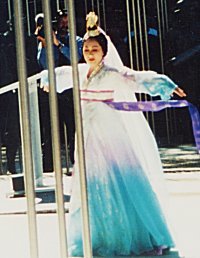General Paik, Sun Yup1 of the Republic of Korea visited Australia for the dedicationof the Memorial and on 19th April, 2000, General Paik hosted a dinner in Sydney -for Korean Nationals who served during Korean War and now live in Australia andfor Australian veterans of that war.
In a speech given on behalf of all General Paik's dinner guests, Olwyn Green, afterthanking the General for his generous hospitality, commented on the unity that theKorean War had created and how this had been reflected in the design of the NationalKorean War Memorial:
"...The bond between our countries that began on the battlefield in 1950 has growninto a familial bond. In a word, we have become family... .We fought together in theKorean War to preserve liberty, which allows opportunity for free and originalexpression. The exquisitely beautiful dance of peace, specially created for thededication ceremony at Canberra, and performed by a Korean professor, achievedwhat only creative art can do: it appealed to the emotions and the imagination.
How could this dance fire people's aspiration and imagination - ours and all whoviewed it? It signified the relationship between our two peoples; it suggested that thehuman potential could be devoted to creating rather than to destroying. The design ofthe memorial also appeals to the imagination. It reflects a significant shift frommilitarism to the contemplation of the unique, united effort of 21 nations and thesacrifice of 339 Australians' lives to preserve liberty. The rocks from the battlefieldwere thoughtfully incorporated in the design to symbolise the site of the war and theconsiderable sacrifice of blood that was made on those rocks, on those hills in Korea."
1 General Paik's distinguished service is summed up in the following extract from thejacket of his book in English "From Pusan to Panmunjorn" which has a foreward byGen. Matthew B. Ridgway and Gen. James A. Van Fleet, published in 1992 byBrassey's, New York. General Paik was "the foremost ROK general of the KoreanWar. Commander of the Republic Of Korea Army's 1st Division - the unit that seizedthe centre of Pyongyang. One of the heroes of the defense of Pusan. Twice recipientof his country's highest military award. The ROK Army's first four-star general... "
|
|
